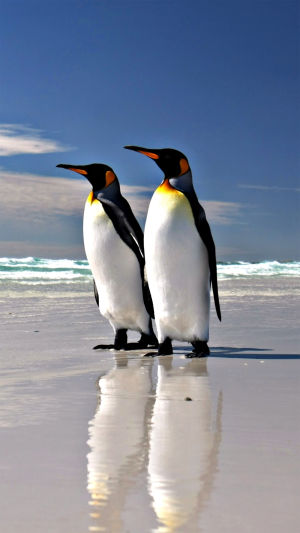Penguins are birds that live in Antarctica and the surrounding seas and belong to the penguin idea in the order Birds. Their bodies are bulky, ranging between 30 and 120 cm in length and weighing between 1 and 45 kg. and their bodies are covered with thick feathers which enable them to survive in extremely cold conditions.
Penguins are extremely adaptable birds that can survive in the ocean, on sea ice, and land. Their diet consists mainly of marine life such as fish, crustaceans, and squid.
They swim very fast in the water, the fastest speed can reach 35 kilometers per hour. On land, their bodies are not adapted for flight, but they can glide on snow and even jump on ice.
Penguins are social animals and usually live in large groups. They often form breeding colonies, congregating to hatch eggs and care for the young.
The penguin breeding season usually occurs during Antarctica's summer, between November and February. Baby birds need long hours of care and feeding after birth to grow into adults.
The natural enemies of penguins are as follows:
Seals and fur seals: Seals and fur seals are one of the main predators of penguins in the ocean. They usually hunt penguins in the water, drag them underwater, and eventually eat them.
Cetaceans: Some cetaceans also prey on penguins. Especially killer whales and orcas, which typically swim in the ocean and then attack penguins from the surface.
Birds: Other birds may also be natural predators of penguins. For example, birds such as anteaters, Antarctic plovers, and Antarctic petrels in Antarctica prey on penguin eggs and chicks.
Humans: Human activities may also pose a threat to penguins. For example, overfishing and environmental pollution may lead to insufficient penguin habitat and food supply, which has an impact on penguin survival.
Although penguins have many natural enemies, they have adapted to the environment of the Antarctic and surrounding oceans during their evolution, and have some special abilities to adapt to these natural enemies, such as swimming fast in the sea, gliding on land, and protecting eggs and young birds with their feet wait. In addition, penguins have relatively few natural enemies, and they also play an important role in the Antarctic ecosystem.
Here are some interesting facts about penguins:
1. Penguins don't build nests on the Antarctic continent, but place their eggs and chicks on their feet so they can protect themselves in extreme cold.
2. The black and white feathers of penguins are actually a protective color. Their black backs make them appear darker in water, while their white bellies make them harder to detect below the surface.
3. More than 50% of the penguin population lives outside Antarctica, including Chile, Argentina, South Africa, Australia, and New Zealand.
4. Penguins can swim in water for hours and can dive to depths of up to 500 feet (about 150 meters).
5. The largest penguin is the emperor penguin, which can reach up to 4 feet (1.2 meters) tall and weigh up to 90 pounds (40 kilograms).
6. Penguins are birds that "dance". They attract their mates or show off their graceful posture by circling, shaking their heads, and flapping their wings.
7. Penguins are also active at night, and they are often seen on Antarctic icebergs during polar nights.
8. Penguins are highly social birds and they often form large breeding colonies that can number in the thousands.
9. Penguins have eating habits similar to humans in that they seek out the most nutritious food and use it as their main food source. They are also the only birds that can prey on sharks in the ocean.
10. In movies and TV, penguins are often portrayed as cute, so they have been loved and noticed by people and become one of the most popular animals.





